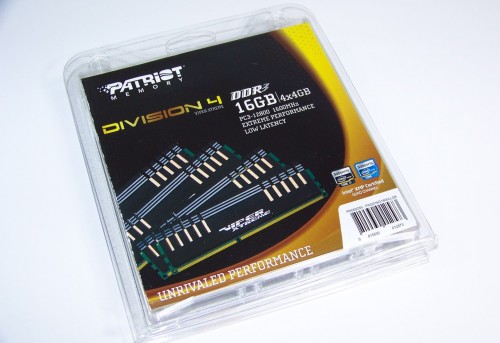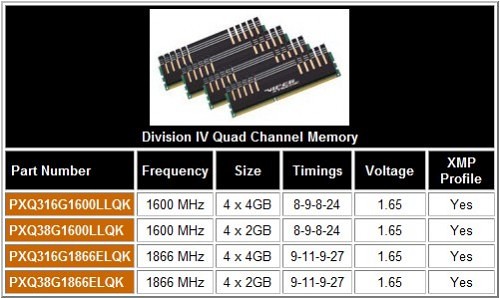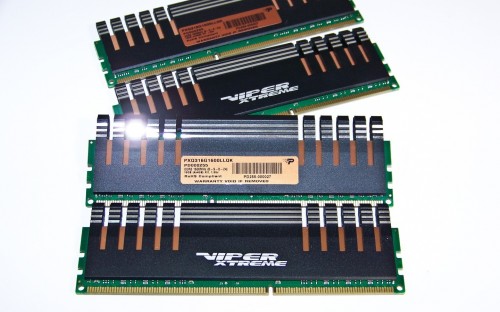We were all surprisingly content with dual channel memory performance when Intel announced triple channel memory support in Gulftown processors. Then just as we got use to the high-speed triple channel performance being the most efficient method for delivering epic amounts of memory bandwidth for big projects, Intel again changed the way content creators get their work done by giving us quad channel memory support inside Sandy Bridge-E processors. But what exactly is the benefit of all those channels? Let’s see if the Patriot Memory Division IV Viper Extreme Memory Kit has those answers!
Features and Specifications
Currently, there are four Division IV quad channel memory kits to choose from ranging from 1600 to 1866MHz. Remember, Intel Sandy Bridge-E processors support 1600MHz DDR natively so there’s no need for slower 1333MHz memory. (It’s about time!)
From the table, you can see the differences from kit to kit. While the entry level kits offer 4 x 2GB sticks, the largest kits are 4 x 4GB. There are larger 8GB modules on the way for those that want to max their 4 and 8 DIMM slot motherboards. Just remember, 8GB is plenty for standard users and gamers. Larger kits will pad your system nicely if you use multiple large programs at once.
The pricing for the 1600MHz kit as tested is around $110 – 120 US on the street which places this just a little above what you would pay for two 2x4GB dual channel kits to reach the same clock speed and memory density. But due to the slightly tighter timing and testing that goes into validating quad channel reliability at these speeds, the premium is necessary. There’s just not as much room for error when running four channels. Especially when overclocking them.
Understanding Dual, Triple and Quad Channel
Let’s cut to the chase for the many regular folks who want to know the differences between channels. Some of AMD’s and Intel’s processors can access two memory sticks at once – thus dual channel. Intel’s processors compatible with X58 motherboards can access three memory sticks at once – thus triple channel. And, Intel’s latest Sandy Bridge-E processor can access four memory sticks at once giving us quad channel performance. Each step in the channel interface is another jump in memory bandwidth which can be a big gain in system performance for some applications. You’ll see this in action in the benchmarks later.
Each corresponding channel interface allows the processor to access and utilize larger amounts of data through the memory. Big data intensive programs load faster while others used in things like rendering, are quicker the more channels used. The only benefit gamers typically see are slightly quicker load times. If you really want quicker program performance all around, order an SSD instead because that’s the true bottleneck. But if you already have an SSD, then memory bandwidth is a place you can improve on.
Test System and Configuration
Three different systems were used to compare dual, triple and quad channel memory performance. We have a Z68, X58 and X79 configured using the same speed memory.
Dual Channel System
- Processor: Intel Core i7-2600K Sandy Bridge
- Motherboard: ASRock Z68 Extreme 7 Gen 3
- Memory: Kingston HyperX Genesis 4GB 1600MHz DDR3
- Storage: Patriot Memory 120GB Wildfire SSD
Triple Channel System
- Processor: Intel Core i7-990X Gulftown
- Motherboard: GIGABYTE G1 Killer Assassin (X58)
- Memory: Patriot Memory Viper Extreme 12GB 1333MHz DDR3
- Storage: Patriot Memory 120GB Wildfire SSD
Quad Channel System
- Processor: Intel Core i7-3960X Sandy Bridge-E
- Motherboard: ASUS P9X79 Deluxe
- Memory: Patriot Memory Division IV Viper Extreme 16GB 1600MHz
- Storage: Patriot Memory 120GB Wildfire SSD
Operating system is of course Windows 7 Professional 64-bit fully patched. Each board is using the latest BIOS update as well as Intel INF chipset drivers. A single ZOTAC Geforce GTX 580 video card was used in each system yet has no influence on the benchmarks. Now let’s look at one of the few things that sets memory kits apart: Overclocking!
Memory Overclocking
Since the latest Sandy Bridge and Sandy Bridge-E processors rely on memory straps in the BIOS, the options are essentially 1333, 1600, 1866, and 2133 MHz. That means the memory kit needs to be able to overclock an extra 266 MHz without using voltage that exceeds safe limits. For us, that’s 1.68 volts.
The Division 4 1600 MHz kit did in fact reach 1866 MHz using CAS 10 latencies. In other words, the system resolved memory timings to 10-11-10-30 to achieve stability. In most real world use, this overclock is basically unnecessary. You’ll see why in the memory benchmark and Cinebench results next.
SANDRA – Memory Benchmark
This benchmark loads the memory and CPU’s integrated memory controller to measure data transfer rates between the two. In this respect, the XMP profiles are used in the BIOS which means the Gulftown and Sandy Bridge are slightly overclocked. Still, you will see the differences between the number of memory channels in use.
As observed, the data transfer rates increase each time a stick, or channel, of memory is added from system to system. Quad channel really screams producing just over 38GB/s (per second) data transfer rates. Notice that overlocking the kit doesn’t improve bandwidth that much due to the CAS 10 latency timing.
Cinebench R11.5
Cinenbench rendering is completely CPU intensive and means moving a lot of data back and forth between the processor and memory. For this benchmark, I used just the Division IV memory at 1333 and 1600 MHz using different memory timings so you can see the effect they have on CPU performance.
While the bulk of the scores are due to the CPU, you’ll notice that memory frequencies mostly influenced multi-core scores. Depending on your motherboard’s BIOS, your auto settings may do better. The XMP Profile can also be effected by the BIOS. And, just to be sure, manual settings were applied which is reflected in the results. Big rendering jobs get done faster with faster memory.
PCMark07
Alright, we know that memory speed helps the CPU. But what about something a bit more real world that tests a system’s overall performance? PCMark07 is about as good as it gets in that respect. Let’s see how it does when manipulating some memory timings.
Since the bulk of the performance comes from the processor, I tested the main X79 system using dual, triple and quad channel configurations. Keep in mind the processor and memory can do a lot more when an SSD is used. Thus, we see the difference between the frequencies and timings again.
Final Thoughts
Good quality memory with low timings can do a lot for your processor especially with large programs. The Division IV 1600MHz quad channel kit features CAS8 timings which will give your system a noticeable boost in productivity. While it may not increase a game’s frame rates, it does help load your large games like Battlefield 3 a bit quicker especially if your system has a SATAII or SATAIII SSD.
Besides the great CAS8 performance, the Patriot Memory Viper Extreme Division IV series look really good. The black heat spreaders are simple yet aggressive in appearance. The copper insert adds a neat little accent to it that helps create what I feel to be the best looking black memory currently available. It’s definitely a performance enthusiast quad channel memory kit worth high consideration.
Ultimately, it comes down to price. The Viper Extreme 16GB CAS8 memory retails for about $110 US at Amazon which is the same cost as similar CAS9 memory from competitors. But if you’re in need of lower profile, attractive, enthusiast level DDR3 Quad Channel memory kit, the Viper Extreme Division IV is what I would recommend today.
Pros
- 16GB 1600MHz with CAS 8 timings
- Attractive, enthusiast design
- XMP worked on Intel, ASUS and GIGABYTE motherboards
- Great bang for buck at $110 US or less
Cons
- Black PCB would sweeten up the design
Overall Score: 9.0 / 10.0
Help Us Improve Our Reviews By Leaving a Comment Below!



